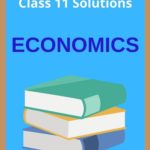Class 11 Economics MCQ Chapter 1 Introduction Solutions to each chapter is provided in the list so that you can easily browse through different chapters Class 11 Economics MCQ Chapter 1 Introduction Question Answer and select need one. NCERT Class 11 Economics MCQ Chapter 1 Introduction Solutions Download PDF. AHSEC Class 11 Economics Multiple Choice Solutions.
Class 11 Economics MCQ Chapter 1 Introduction
Also, you can read the NCERT book online in these sections Solutions by Expert Teachers as per Central Board of Secondary Education (CBSE) Book guidelines. NCERT Class 11 Economics Objective Type Solutions are part of All Subject Solutions. Here we have given AHSEC Class 11 Economics Multiple Choice Question and Answer, HS First Year Economics MCQ Solutions for All Chapters, You can practice these here.
Introduction
Chapter: 1
PART – (A) STATISTICS FOR ECONOMICS
| MCQ |
1. ‘Economics is a study of mankind in the ordinary business of life.’ This definition is given by:
(a) Adam Smith.
(b) Prof. Samuelson.
(c) Prof. Ribbons.
(d) Alfred Marshall.
Ans: (d) Alfred Marshall.
2. What does “ordinary business of life” refer to in the context of economics?
(i) Activities for pleasure.
(ii) Non-monetary social activities.
(iii) Economic activities undertaken for monetary gain.
(iv) Personal hobbies and interests.
Ans: (iii) Economic activities undertaken for monetary gain.
3. Economics is considered as a/an:
(a) Science.
(b) Art.
(c) Both (a) and (b)
(d) None of these
Ans: (c) Both (a) and (b)
4. How does Statistics help solve economic problems?
(a) By avoiding the study of past events.
(b) By evaluating the effectiveness of policies.
(c) By ignoring current data.
(d) By focusing only on international data.
Ans: (b) By evaluating the effectiveness of policies.
5. The person who produces goods and services to satisfy human wants is known as:
(a) Producer.
(b) Consumer.
(c) Seller.
(d) Buyer.
Ans: (a) Producer
6. When you are in a job, working for some other person, and you get paid for it , you are called an:
(a) Employer.
(b) Businessman.
(c) Employee.
(d) Entrepreneur.
Ans: (iii) Employee.
7. ________ is the process through which consumers satisfy their wants by using various goods and services.
(a) Production.
(b) Distribution.
(c) Consumption.
(d) None of these.
Ans: (c) Consumption.
8. What is the root of all economic problems according to the passage?
(a) Unlimited wants
(b) Limited technology
(c) Scarcity of resources
(d) Rising prices
Ans: (c) Scarcity of resources
9. _______ produces goods and services
for the generation of income.
(a) Consumer.
(b) Producer
(c) Both (a) and (b)
(d) Neither (a) nor (b)
Ans: (b) Producer.
10. Many alternative goods to choose from, what to buy when he knows the prices. This is the study of _________?
(a) Distribution.
(b) Production.
(c) Consumption.
(d) None of the above.
Ans: (c) Consumption.
11. Which of the following is an economic activity?
(a) A farmer growing wheat for self-consumption.
(b) A father buying books for his children.
(c) A person going to a temple.
(d) Both (a) and (b).
Ans: (d) Both (a) and (b)
12. These studies required that we know more about economic facts. Such economic facts are also known as __________?
(a) Economic analysis.
(b) Economic Policies.
(c) Economic data.
(d) All of the above.
Ans: (c) Economic data.
13. An economic problem arises as:
(a) Human wants are unlimited.
(b) Means are limited.
(c) Resources have alternative uses.
(d) All of these.
Ans: (d) All of these.
14. Who is referred to as a seller in Economics?
(a) Someone who buys goods.
(b) Someone who sells goods to make a profit.
(c) Someone who provides services.
(d) Someone who manufactures goods.
Ans: (b) Someone who sells goods to make a profit.
15. ________ is the root cause of all economic problems.
(a) Alternate use of resources.
(b) Unlimited wants.
(c) Scarcity.
(d) All of these.
Ans: (c) Scarcity.

Hi! my Name is Parimal Roy. I have completed my Bachelor’s degree in Philosophy (B.A.) from Silapathar General College. Currently, I am working as an HR Manager at Dev Library. It is a website that provides study materials for students from Class 3 to 12, including SCERT and NCERT notes. It also offers resources for BA, B.Com, B.Sc, and Computer Science, along with postgraduate notes. Besides study materials, the website has novels, eBooks, health and finance articles, biographies, quotes, and more.




